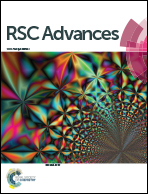Temperature-triggered order–disorder phase transition in molecular-ionic material N-butyldiethanolammonium picrate monohydrate†
Abstract
A new molecular-ionic phase transition material, N-butyldiethanolammonium picrate monohydrate (BEAPM), which exhibits reversible switchable dielectric performances, has been successfully assembled. This compound undergoes a first-order solid-state phase transition at 160 K (Tc), which is confirmed by the thermal analyses including differential scanning calorimetry (DSC), specific heat (Cp) and dielectric measurements. Variable-temperature single crystal X-ray diffraction reveals that the origin of its phase transition is ascribed to the order–disorder transformation of oxygen atoms of the poly-nitro aromatic system, i.e. the picrate anions. Interestingly, the dielectric constants display clear temperature-dependant anomalies with the temperature approaching to Tc. The evident step-like anomalies of dielectric constants demonstrate two distinct states below and above the Tc, respectively. This result signifies that BEAPM could be conceived as a potential switchable dielectric material. These findings make us believe that BEAPM might be a potential solid–solid dielectric phase transition material.


 Please wait while we load your content...
Please wait while we load your content...